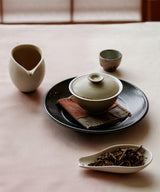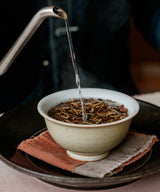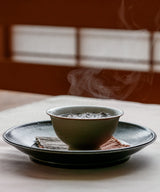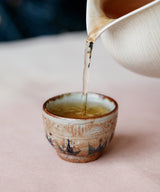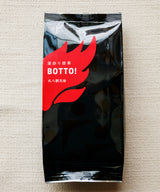Kaga Dark Roast Bancha BOTTO!
加贺重焙棒茶
Origin
Kaga, Ishikawa
Maruhachi Tea Factory was founded in Kaga, Ishikawa Prefecture in 1863. This tea factory has been making the finest roasted teas for six generations, from the Edo Period to the present day. They have maintained their reputation by focusing on the quality and parts of the tea tree used, the consistent blending of the tea stems, and their refined method for roasting them.
Between the Edo Period and the Showa Period, tea trees were cultivated in what is now Kaga City of Ishikawa Prefecture. Tea production was quite large at the time, with many teas from Kaga being exported to the US. At this scale of production, tea leaves were harvested by machine, a process by which stems are mixed in with the tea leaves. After machine harvest, the leaves are separated and used to make sencha, gyokuro and matcha. It came to be that the left over stems would be roasted and enjoyed by the local people of Kaga: this is the origin of “stem tea,” or bocha.
After many years of practice with roasting tea, Maruhachi Tea Factory was asked to produce the finest quality bocha for Emperor Showa, the 124th emperor of Japan, who happened to favour roasted teas as he grew older.
What gives Maruhachi Tea Factory's teas its clean and complex fragrance is the traditional roasting method the stems go through. There are two methods of roasting tea in Japan. One is the direct-fire method, in which tea leaves and/or stems are roasted directly on a hot iron plate. The second, and more time consuming one, is a sand-roasting method by which leaves and stems are mixed with sand, and then roasted. In this way, the tea is heated slowly and indirectly by the radiating sand. The warm sand gradually transfers heat to the center of the tender stems, bringing out the umami and complexity of first harvest tea without over-roasting. With the direct-fire method, the one most commonly used for hojichas, the roasted tea has a strong aroma and taste, and brews a dark liquor. With sand-roasting, the tea liquor is lighter in colour, and has a more nuanced aroma and taste.
Since being founded in 1863, Maruhachi Tea Factory has only ever made bocha using the sand-roasting method. Nowadays, with consideration for food safety, instead of sand Maruhachi uses customized ceramic heaters that slowly roast the stems to the core, just as the sand would.
Maruhachi specializes in lightly roasted tea, but in Botto! we see them using a slightly stronger roast to bring out even more of the character of the tea leaves. This dark-roast roasted hojicha is unique to Maruhachi teahouse, and stands apart from other dark roast tea we’re familiar with.
The deep, complex, almost mineral notes of this tea are brought out by several rounds of slow roasting. Botto ends up having a coffee-like quality: it feels palate-rinsing, like dandelion or cigarettes. These structural, ashy characteristics make us think it is a perfect after dinner tea – it leaves us with a sense of completion.
Net weight 80g
. . .
Hot Brewing Guide
| Tea | 4g |
| Water | 180ml |
| Temperature | 100 °C |
| Steep time | 30 sec - 120 sec |
| No. of infusions | 3 |


